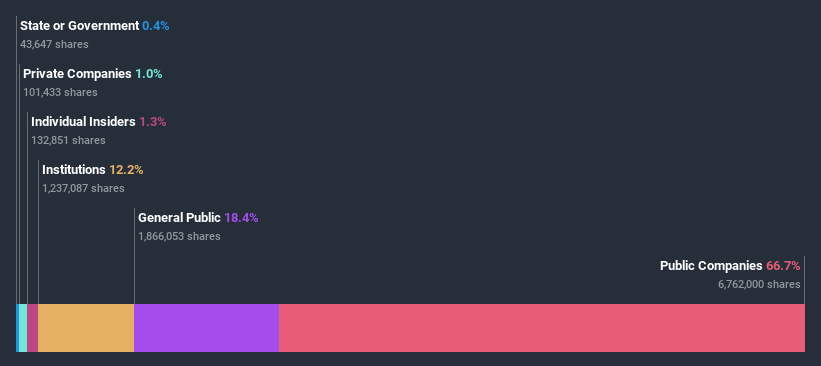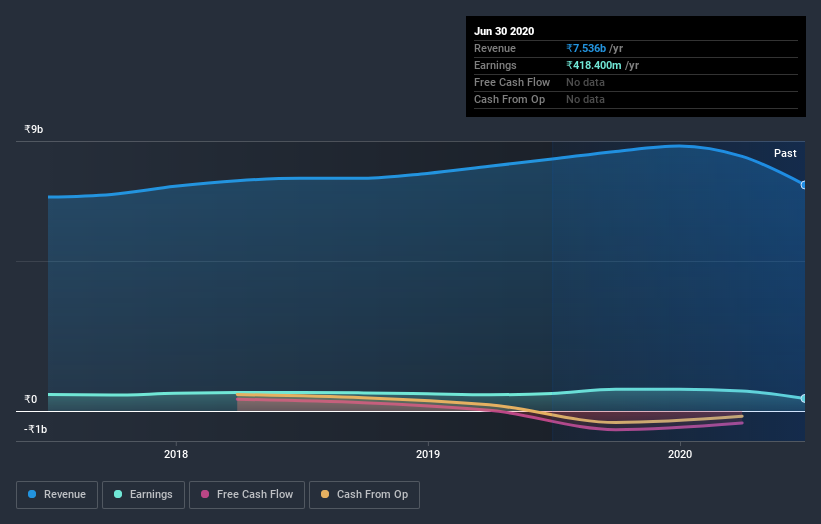Here's What Honda India Power Products Limited's (NSE:HONDAPOWER) Shareholder Ownership Structure Looks Like

A look at the shareholders of Honda India Power Products Limited (NSE:HONDAPOWER) can tell us which group is most powerful. Insiders often own a large chunk of younger, smaller, companies while huge companies tend to have institutions as shareholders. Companies that have been privatized tend to have low insider ownership.
Honda India Power Products is not a large company by global standards. It has a market capitalization of ₹10.0b, which means it wouldn't have the attention of many institutional investors. In the chart below, we can see that institutions are noticeable on the share registry. We can zoom in on the different ownership groups, to learn more about Honda India Power Products.
See our latest analysis for Honda India Power Products

What Does The Institutional Ownership Tell Us About Honda India Power Products?
Many institutions measure their performance against an index that approximates the local market. So they usually pay more attention to companies that are included in major indices.
We can see that Honda India Power Products does have institutional investors; and they hold a good portion of the company's stock. This implies the analysts working for those institutions have looked at the stock and they like it. But just like anyone else, they could be wrong. When multiple institutions own a stock, there's always a risk that they are in a 'crowded trade'. When such a trade goes wrong, multiple parties may compete to sell stock fast. This risk is higher in a company without a history of growth. You can see Honda India Power Products' historic earnings and revenue below, but keep in mind there's always more to the story.

We note that hedge funds don't have a meaningful investment in Honda India Power Products. Looking at our data, we can see that the largest shareholder is Honda Motor Co., Ltd. with 67% of shares outstanding. This essentially means that they have extensive influence, if not outright control, over the future of the corporation. Nippon Life India Asset Management Limited is the second largest shareholder owning 8.4% of common stock, and Tata Asset Management Limited holds about 2.4% of the company stock.
While it makes sense to study institutional ownership data for a company, it also makes sense to study analyst sentiments to know which way the wind is blowing. Our information suggests that there isn't any analyst coverage of the stock, so it is probably little known.
Insider Ownership Of Honda India Power Products
The definition of company insiders can be subjective and does vary between jurisdictions. Our data reflects individual insiders, capturing board members at the very least. Company management run the business, but the CEO will answer to the board, even if he or she is a member of it.
I generally consider insider ownership to be a good thing. However, on some occasions it makes it more difficult for other shareholders to hold the board accountable for decisions.
I can report that insiders do own shares in Honda India Power Products Limited. As individuals, the insiders collectively own ₹131m worth of the ₹10.0b company. This shows at least some alignment, but I usually like to see larger insider holdings. You can click here to see if those insiders have been buying or selling.
General Public Ownership
With a 18% ownership, the general public have some degree of sway over Honda India Power Products. This size of ownership, while considerable, may not be enough to change company policy if the decision is not in sync with other large shareholders.
Public Company Ownership
It appears to us that public companies own 67% of Honda India Power Products. We can't be certain but it is quite possible this is a strategic stake. The businesses may be similar, or work together.
Next Steps:
It's always worth thinking about the different groups who own shares in a company. But to understand Honda India Power Products better, we need to consider many other factors. Consider risks, for instance. Every company has them, and we've spotted 1 warning sign for Honda India Power Products you should know about.
Of course, you might find a fantastic investment by looking elsewhere. So take a peek at this free list of interesting companies.
NB: Figures in this article are calculated using data from the last twelve months, which refer to the 12-month period ending on the last date of the month the financial statement is dated. This may not be consistent with full year annual report figures.
If you’re looking to trade Honda India Power Products, open an account with the lowest-cost* platform trusted by professionals, Interactive Brokers. Their clients from over 200 countries and territories trade stocks, options, futures, forex, bonds and funds worldwide from a single integrated account. Promoted
Valuation is complex, but we're here to simplify it.
Discover if Honda India Power Products might be undervalued or overvalued with our detailed analysis, featuring fair value estimates, potential risks, dividends, insider trades, and its financial condition.
Access Free AnalysisThis article by Simply Wall St is general in nature. It does not constitute a recommendation to buy or sell any stock, and does not take account of your objectives, or your financial situation. We aim to bring you long-term focused analysis driven by fundamental data. Note that our analysis may not factor in the latest price-sensitive company announcements or qualitative material. Simply Wall St has no position in any stocks mentioned.
*Interactive Brokers Rated Lowest Cost Broker by StockBrokers.com Annual Online Review 2020
Have feedback on this article? Concerned about the content? Get in touch with us directly. Alternatively, email editorial-team@simplywallst.com.
About NSEI:HONDAPOWER
Honda India Power Products
Engages in the manufacture, marketing, and sale of portable generators, water pumps, general purpose engines, lawn mowers, brush cutters, portable gensets, tillers, and marine engines in India and internationally.
Flawless balance sheet second-rate dividend payer.
Market Insights
Community Narratives




